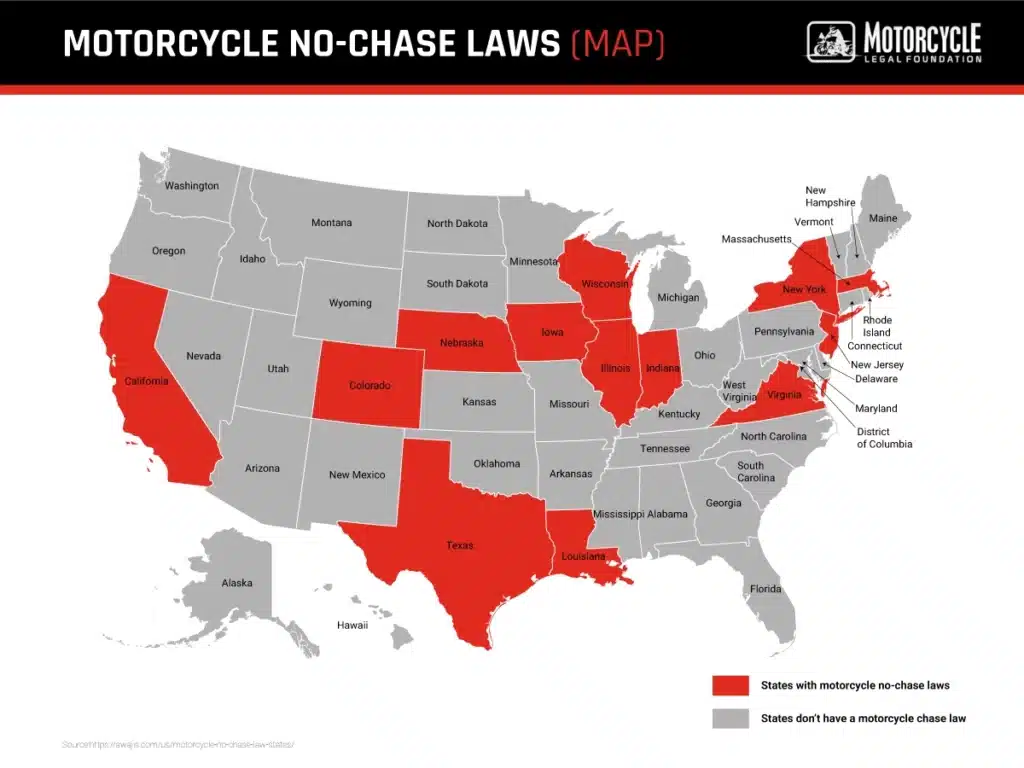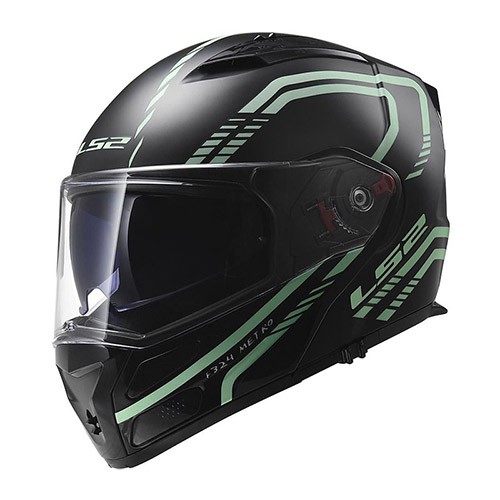Police vehicles in high-speed pursuit of suspects fleeing on motorcycles and in cars through crowded streets have entertained movie and television audiences for decades. Don’t be surprised to learn that the chance of seeing a high-speed chase by police in real life is far less likely.
Law enforcement agencies throughout the United States do not have the luxury of closed streets and highly controlled conditions when pursuing a motorcycle whose rider has broken the law. States and some local jurisdictions passed laws establishing procedures or requiring law enforcement agencies to create procedures for officers to follow when initiating and during the pursuit of another vehicle.
One thing motorcycle no-chase laws do not do is infringe on the discretion of law enforcement officers to determine when pursuing a suspect fleeing on a motorcycle or other type of vehicle should be undertaken. Instead, the laws and department procedures attempt to balance a police officer’s duty to catch and arrest criminals with the officer’s responsibility to consider the risks that high-speed chases pose to the officers, the general public, and the person chased.
As you read through this article, you’ll learn about the laws and policies that exist in the U.S. covering police pursuits. We’ll also explain the factors determining whether to pursue a criminal offender and those that may lead to officers terminating a chase.
What are motorcycle no-chase laws?
Hearing or seeing “motorcycle no-chase laws” could lead you to believe that a law prevents police officers from chasing a motorcycle rider they believe broke the law. That’s not exactly right.
Motorcycle no-chase laws, also known as no-chase or no-pursuit rules, regulations, policies, or procedures, gives officers guidelines to follow that take into consideration the need to make an arrest with the safety of the participants in a chase and the general public. A no-chase law for motorcycles recognizes that other and safer methods may be available to catch an offender, including:
- Having police cars block the roadway ahead to stop a suspect.
- Use of surveillance and traffic cameras along the route to monitor the location of a suspect.
- Use of police helicopters and airplanes to track the route taken by a suspect.
Instead of officers engaging in a high-speed chase endangering their lives and the lives of innocent motorists and pedestrians, a motorcycle no-chase law presents a process for officers to consider safer alternatives. For example, a police officer may follow at a safer speed while monitoring a motorcyclist’s location through information provided by traffic cameras along the route.
What is the purpose of motorcycle no-chase laws?
Can cops chase motorcycles? The answer is yes because the purpose of a no-chase law motorcycle guidelines is not to tell police they cannot use discretion to apprehend someone who breaks the law. The purpose of laws or rules is to keep everyone safe while letting police enforce the laws.
Accidents are an ever-present danger when vehicles travel at high speeds through streets used by innocent third parties. According to a report from the California Highway Patrol, 23.3% of police pursuits in the state resulted in a crash. Of the deaths and injuries attributed to crashes in police chases, 40% of the fatalities and 30.8% of those injured were third parties who were not participants in the chase.
Some of the reasons why governments and police agencies have adopted guidelines and procedures for police chases include the following:
- Protect the public: The statistics from the California Highway Patrol clearly show the danger of death and injury to innocent parties in accidents occurring when police chase a motorcycle rider. No-chase motorcycle laws and policies emphasize public safety by drawing police attention to the accident dangers a high-speed chase creates. Capturing a suspect for a minor criminal or traffic offense is not worth the risk of injuring or killing an innocent person.
- Protecting the motorcycle operator: A motorcycle rider fleeing at high speed from what may be a minor traffic violation, such as riding without a license, risks losing control of their bike, crashing, and dying to avoid a fine. No-chase policies that consider the severity of the violation could avoid crashes caused by pursuits of suspects for minor offenses.
- Constitutional rights at risk: According to the United States Constitution, everyone accused of committing a crime is presumed innocent. That includes a person on a motorcycle who attempts to outrun police rather than submit to an arrest. A person fleeing from police may be foolish and reckless for not pulling over, but they also may be innocent of the criminal conduct police suspect them of committing.
- Liability issues: Accidents occurring during a police chase may result in lawsuits against the police department or the state and local governments. Departments and governments seek to avoid or limit their liability through no-chase policies.
Guidelines for no-chase law motorcycles establish procedures that an officer needs to follow in determining when to initiate, continue, or terminate the pursuit of a motorcyclist or any vehicle that fails to pull over as directed.
Motorcycle no chase laws in states and cities

The no-chase law for motorcycles enacted by state or local governments, or the policies adopted by individual law enforcement agencies, vary in how restrictive they are in curtailing an officer’s discretion. For example, a new law enacted in the state of Washington limits police pursuits only to instances where the suspect committed a serious as opposed to a minor criminal offense. Even when authorized, the law requires that officers pursuing another vehicle be in radio communication with other police officers.
The Washington law imposes other procedures once a chase begins, such as requiring the pursuing officer or a supervisor to have a plan for ending the pursuit through an intervention technique. A plan could involve using a spike strip to deflate the ires of the other vehicle, but this may not be an option due to the risk of serious injury when the other vehicle is a motorcycle.
The following gives you examples of policies adopted by police departments or through state and local laws in jurisdictions throughout the country:
- Local police departments in Albany, NY, Bedford, MA: Vehicular pursuit policies adopted by these departments are similar in emphasizing that officers must consider public safety and the safety of other officers when initiating or continuing high-speed pursuit of a suspect. Various factors must be considered., such as the danger the suspect poses to the public and the seriousness of the offense.
- Nebraska: The state enacted a law requiring law enforcement agencies to create and implement motorcycle no-chase policies for initiating, continuing, and terminating vehicle pursuits.
- Illinois Police Guidelines: Statewide guidelines exist in Illinois, requiring local departments throughout the state to create and adopt procedures for officers to follow regarding vehicle pursuits. The statewide guidelines include plans for terminating a pursuit using recommended and approved measures, such as roadblocks.
- Iowa Department of Public Safety guidelines: Statewide policies governing chasing suspect’s vehicles in Iowa include limiting the tactic to the most serious misdemeanor and felony offenses. As with other no chase law for motorcycles states have done, Iowa makes public safety and the safety of other officers a priority in the decision to initiate, continue, or terminate a chase of another vehicle.
If you wonder if California has a no-chase law for motorcycles, it does. Like other states, the law requires local departments to create and implement pursuit policies. The policies must balance public safety, the risk to other officers and innocent motorists, and other factors in deciding to begin, continue, or end a chase.
Takeaways
States with no-chase laws for motorcycles do not prohibit the pursuit of people to make an arrest. Instead, they establish guidelines to ensure the safety of the public, the officers, and suspects while allowing law enforcement officers to enforce the law. Keeping the roads safe for motorists, pedestrians, motorcycle riders, and police officers is the primary purpose of no-chase policies.
Frequently Asked Questions
The laws reduce accident risks to innocent third parties by emphasizing public safety with rules for officers to follow to reduce the risk of accidents.
All motorcycle no-chase laws do is avoid dangerous, high-speed chases. Surveillance cameras and other methods allow the police to identify and later apprehend a person suspected of committing a crime.
No, each state and each local law enforcement agency within a state adopts its own policies. Some policies may limit chases to only violent crime situations, while others are less rigid.
No, some states leave it to local city and county governments to pass laws or rely on police departments in the state to adopt their own policies.
Yes, they reduce the risk of accidents. For example, implementing no-chase procedures in Washington State resulted in a dramatic decline in deaths and injuries related to police pursuit crashes.
The high-speed chase is not the only method police have for catching a fleeing suspect. Common alternatives to pursuit include planes and helicopters, surveillance and traffic cameras, roadblocks, and location information via radio from other police vehicles.
The seriousness of the offense and the risk the suspect poses to the public are vital factors an officer considers when deciding to begin a pursuit. Other factors may include options available for tracking or stopping the suspect. For example, the ability of police to quickly deploy a roadblock using other police vehicles may prevent officers from giving chase.

